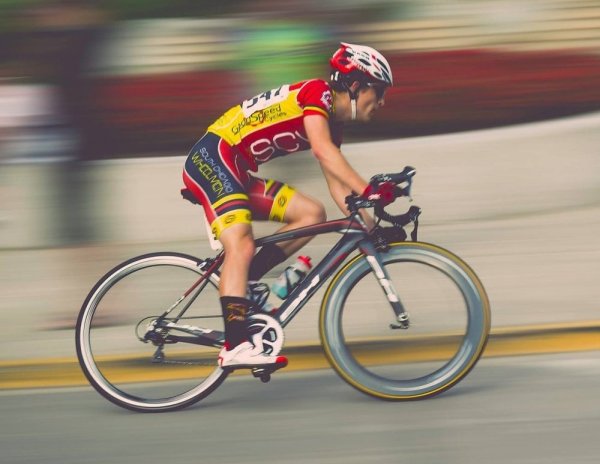yogabook / movement physiology / cycling

Cycling is a cyclical form of locomotion that uses a technical aid, the bicycle, and its wheels to enable uniform locomotion without significant oscillation of the centre of gravity in height and without significant impacts on the lower extremities. Under almost all topographical conditions, the achievable speeds are significantly higher than those for running. If the power output is intermitted, the bike still glides a considerable distance with the existing mass inertia against the low frictional resistance and the maybe significantly higher air resistance, especially depending on the sitting position, while in running only a few steps are possible without the power output serving propulsion until the movement stops. Typically, the force for propulsion is exerted by the lower extremities through cyclically pushing pedals. The proportion between the knee-extending muscles (quadriceps), the hip-extending muscles (primarily the gluteus maximus and hamstrings, as well as the adductor magnus with its posterior fibres originating from the ischiadic tuberosity) and the triceps surae can be shifted to a greater extent, which can be used to counteract the premature fatigue of one of these groups. This, together with the „self-running“ of the bike as opposed to the legs, enables not only higher speeds than running but also significantly greater distances to be covered in one go.
Important parameters when cycling are the height of the seat above the crank axle, which should not be chosen so that the knee joint cannot be stretched, and its relationship to the height of the handlebars. This ratio has a decisive influence on the aerodynamics of the riding position, but also on posture and the working ranges of the hip extensors and hip flexors involved in propulsion. A lower handlebar compared to the seat improves aerodynamics, but forces a very rounded back in the thoracic spine and lumbar spine. However, due to the partial body weight supported by the arms, this does not usually represent a clear predisposition to intervertebral disc problems. Strength training of the autochthonous musculature is very helpful against this and also avoids the „cyclist’s hump“ often seen in the past. On the other hand, incorrect posture of the wrists can sometimes lead to difficulties in these joints, especially if the wrist is bent into dorsiflexion and additional impacts from uneven ground act on the radiocarpal joint. If the handlebars are lower than the seat, not only does the back have a considerable degree of curvature, but the cervical spine also has to hyperlordose significantly so that the route to be travelled is still in the field of vision. This often leads to unpleasant hypertonus with a cramp-like flavour, even in experienced riders. However, serious disorders are rare here, but not the worsening of pre-existing symptoms. The cyclical movement of the lower extremity with significant contraction forces of the quadriceps can in principle affect the force-transmitting chain consisting of the quadriceps muscle itself, its tendon, the patella, the patellar ligament and the tibial tuberosity as the insertion of the patellar ligament, but this is more likely to occur if there are disruptive factors such as an incorrectly shaped patella or if the gear is often chosen in favour of heavier rather than more frequent pedalling, especially on hills. Disorders such as runner’s knee are more common. There are some typical predisposing factors for overuse, such as changes in biomechanical parameters (saddle height, handlebar height, footwear, frame stiffness), cold and wet conditions.
In most cases, it is the tendons rather than the joints that are affected, in the ankle especially the Achilles tendon or the fibularis group. In the knee joint, it can affect the quadriceps tendon or tendons of the
hamstrings. Insertional tendinopathies are more persistent with increasing age, and disruptive factors such as muscular imbalances must be clarified and addressed. Compared to running athletes, meniscus damage is quite rare, damages to the femoropatellar sliding bearing a little more common, although still rather rare. The prolonged highly hip-flexed posture tends to cause disruption of the femoral artery, which lengthens and kinks, usually causing an initially unilateral supply disorder that manifests itself as a lack of performance or fatigue in one leg, which is inconsistent with the level of training. If it persists for a longer period of time, a permanently performance-reducing stenosis can develop, which requires surgical treatment in order to continue practising the sport. Cyclists are particularly susceptible to gastritis and electrolyte deficiency in summer.
Another disorders sometimes reported by cyclists concerns the
piriformis. Under certain circumstances, this tends to overexertion and painful hypertonus. DGS (piriformis syndrome) with nerve pain radiation can also occur. For the piriformis, due to its location, the cooling airstream can be a cofactor. A previous training break can also favour the occurrence. It can also be discussed whether athletes primarily involved in running or sports with a high or frequent fast running component are predisposed to this, as they may be inclined to derive more of their propulsion during cycling than other people from their hip extensors, which are better trained than the quadriceps in runners. It is also clear that heavy rather than frequent pedalling favours triggering.
